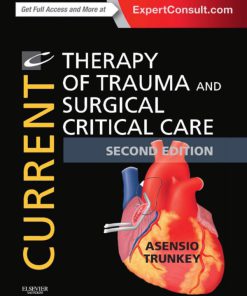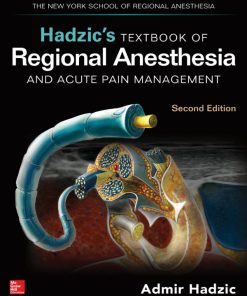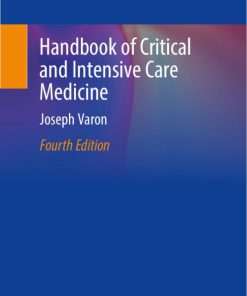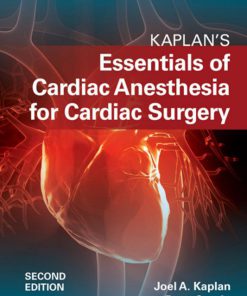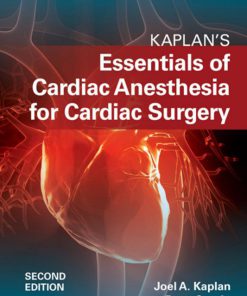Essentials of Trauma Anesthesia 2nd Edition by Albert Varon, Charles Smith ISBN 9781108363709 1108363709
$50.00 Original price was: $50.00.$25.00Current price is: $25.00.
Authors:Essentials of Trauma Anesthesia-Cambridge University Press (2018) , Author sort:Press, Essentials of Trauma Anesthesia-Cambridge University
Essentials of Trauma Anesthesia 2nd Edition by Albert Varon, Charles Smith – Ebook PDF Instant Download/Delivery. 9781108363709 ,1108363709
Full download Essentials of Trauma Anesthesia 2nd Edition after payment
Product details:
ISBN 10: 1108363709
ISBN 13: 9781108363709
Author: Albert Varon, Charles Smith
Essentials of Trauma Anesthesia 2nd Edition Table of contents:
Section 1 Core Principles in Trauma Anesthesia
Chapter 1 Trauma Epidemiology, Mechanisms of Injury, and Prehospital Care
Trauma Epidemiology
Funding for Research
Prevention
Mechanisms of Injury
Falls
Transportation-related Injuries
Penetrating Trauma
Blasts or Explosions
Prehospital Care
Trauma Management in the Prehospital Phase
Airway and Ventilation Management
Breathing
Circulation
Disability/Exposure
Triage
Key Points
Further Reading
Chapter 2 Initial Evaluation and Management
Introduction
Before the Patient Arrives
Prehospital Coordination
Trauma Area Setup
Prioritizing Trauma Care
First Contact
Primary Survey
Resuscitation Phase
Secondary Survey
Additional Considerations
FAST Exam
CT Imaging
Angiography
Prioritization of Surgical Management
Teamwork and CRM in Trauma
Key Points
Further Reading
Chapter 3 Airway Management
Introduction
Airway
Equipment and Medications
RSI: anesthetic agents and NMBDs
Oxygenation and Cricoid Pressure
Cervical Spine Immobilization
ASA Difficult Airway Algorithm Modified for Trauma
Videolaryngoscopy
Tracheal Tube Introducers
Supraglottic Devices
Laryngeal Mask Airway
Laryngeal Tube Airway
Flexible Bronchoscopy
Surgical Airway
Penetrating Neck Injury
Key Points
Further Reading
Chapter 4 Shock, Resuscitation, and Fluid Therapy
Shock
Pathophysiology
Diagnosis and Recognition
Fluid Therapy
Timing and Rate of Fluid Administration
Fluid Alternatives for Small Volume Resuscitation
Resuscitation from Hemorrhage
Early Resuscitation
Late Resuscitation
Damage Control Hemostatic Resuscitation
Key Points
Further Reading
Chapter 5 Vascular Cannulation
Introduction
General Considerations
Factors Influencing Flow
Ultrasound-Guided Procedures
Venous Access
Peripheral Venous Access
Central Venous Access
Site of Venous Catheterization
Subclavian Vein
Landmark Technique
Ultrasound Technique
Internal Jugular Vein
Femoral Vein
Types of Central Venous Catheters
Small-Bore Multi-lumen Catheters
Large-Bore Single-Lumen Catheters (“Introducers”)
Large-Bore Multi-Lumen Catheters
Intraosseous (IO) Access
Arterial Access
Sites for Arterial Catheterization
Radial Artery
Axillary Artery
Femoral Artery
Dorsalis Pedis Artery
Brachial Artery
Key Points
Further Reading
Chapter 6 Blood Component Therapy and Trauma Coagulopathy
Introduction
Hemorrhagic Shock
Pathophysiology of Coagulopathy in Trauma
Blood Products
Blood Product Compatibility and Cross-matching
Approaches to Early Transfusion and Coagulopathy in Trauma
Empiric Transfusion Ratios
Goal-Directed Treatment of Coagulopathy
Organizational and Practical Aspects of Massive Transfusion
Role of Massive Transfusion Protocols
Activation and Scope of Massive Transfusion Protocols
Complications of Massive Transfusion
Procoagulant Adjuncts
Antifibrinolytics
Recombinant and Concentrated Clotting Factors
Fibrinogen Concentrate
The Anticoagulated Trauma Patient
A Pragmatic Approach to Transfusion and Coagulation in Trauma
Key Points
Further Reading
Chapter 7 General Anesthesia for Trauma
Introduction
Preoperative Preparation
Operating Room Setup
Monitoring
General Anesthesia
Airway Management and Anesthetic Agents (see also Chapter 3)
Aspiration Prophylaxis
Cervical Spine Precautions
Airway Compromise
Hypovolemia and Anesthetic Agents
Head Injury and General Anesthesia
Cardiac Injury and Anesthetic Agents
Anesthetic Agents and Burns
Maintaining Normothermia
General Anesthesia and Damage Control Surgery
Key Points
Further Reading
Chapter 8 Regional Anesthesia for Trauma
General Considerations
Regional Anesthesia: Concerns in the Trauma Patient
Obtaining Informed Consent
Hemodynamic Instability
Coagulation Status
Traumatic Nerve Injury
Risk of Infection
Compartment Syndrome
Fall Risk
Ultrasound in Regional Anesthesia
Physics of Ultrasound
Needle Approaches to Nerves
Short Axis – In-plane
Short Axis – Out-of-Plane
Long Axis – In-plane
Long Axis – Out-of-plane
Upper Extremity Blocks
Interscalene Block
Supraclavicular Block
Infraclavicular Block
Axillary Block
Elbow Block
Lower Extremity Blocks
Femoral Nerve Block
Adductor Canal Block
Lateral Femoral Cutaneous Nerve Block
Sciatic Nerve Blocks
Gluteal Approach
Lateral Popliteal Approach
Selection of Local Anesthetic and Catheter Placement for Peripheral Nerve Blocks
Local Anesthetic Toxicity
Neuraxial and Paravertebral Blocks
Subarachnoid Block
Epidural Block
Paravertebral Block
Key Points
Further Reading
Chapter 9 Monitoring the Trauma Patient
Introduction
Non-invasive Monitors
Pulse Oximetry
Non-invasive Blood Pressure Monitoring
Capnography
Electrocardiography
Temperature Monitoring
Transesophageal Echocardiography (TEE)
Awareness Monitoring
Neuromuscular Monitoring
Invasive Monitors
Arterial Catheter
Central Venous Catheter (CVC)
Pulmonary Artery Catheter
Cardiac Output
Venous Saturation
Dynamic Monitors of Fluid Bolus Responsiveness
Intracranial Pressure (ICP) Monitoring
Serum Markers of Tissue Perfusion and Oxygen Debt
Lactate
Base Deficit
Monitoring of Trauma Patients When Monitors Fail
Key Points
Further Reading
Chapter 10 Echocardiography in Trauma
Introduction
Indications for Echocardiography in Trauma Patients Requiring Non-cardiac Surgery
Clinical Applications of Echocardiography in Trauma Patients
Diagnostic Applications
Pneumothorax
Hemothorax
Pericardial Effusion and Cardiac Tamponade
Blunt Aortic Injury and Aortic Dissection
Hypovolemia, Myocardial Contusion (Injury to the Cardiac Myocardium), and Valvular Regurgitation
Monitoring Applications
Volume Status
Ventricular Function
Myocardial Ischemia and RWMAs
Valvular Lesions
Assessment of CO and Hemodynamic Monitoring
Intracardiac and Intrapulmonary Shunting
Pulmonary Emboli; Air and Fat Emboli Monitoring
Performance of the Perioperative Echocardiography Exam
Pre-cardiac Arrest State
Conclusions
Key Points
Further Reading
Chapter 11 Coagulation Monitoring of the Bleeding Trauma Patient
Introduction
Current Concepts of the Coagulation System
Assessment of Coagulation
1. Medical History
2. Clinical Presentation
3. Standard Laboratory Coagulation Tests
4. Bedside Point-of-Care (POC) Coagulation Tests
POC Monitoring of the Entire Coagulation Process
TEG and ROTEM
Sonoclot Coagulation and Platelet Function Analyzer
Simplified Interpretation for TEG/ROTEM Readouts
Standard Laboratory Coagulation Tests versus Viscoelastic Coagulation Tests in Trauma
Economic Aspects of the Utilization of POC Viscoelastic Coagulation Testing
Treatment of Coagulopathy
Conclusions
Key Points
Further Reading
Chapter 12 Postoperative Care of the Trauma Patient
Introduction
Disposition and Transport from the Operating Room (OR)
Secondary Resuscitation
Postoperative Pain Management and Sedation
Ventilator Management
Neurologic Considerations
Cardiovascular Concerns
Renal and Acid/Base Considerations
Gastrointestinal and Nutritional Support
Postoperative Infection and Sepsis
Key Points
Further Reading
Section 2 Anesthetic Considerations for Trauma
Chapter 13 Anesthetic Considerations for Adult Traumatic Brain Injury
Introduction
Epidemiology
Pathophysiology
Preoperative Considerations
Laboratory Investigations
Intraoperative Management
Oxygenation and Ventilation
Anesthetic Technique
Intraoperative Monitoring
Hemodynamic Management
Fluid Management
Anemia
Coagulopathy
Glucose Control
Therapeutic Hypothermia
Decompressive Craniectomy
Non-neurologic Surgery in Neurologically Injured Patients
Emergence from Anesthesia
Key Points
Further Reading
Chapter 14 Anesthetic Considerations for Spinal Cord Injury
Epidemiology
Etiology
Traumatic
Non-traumatic
Pathophysiology
Clinical Presentation and Classification of Spinal Cord Injury
Initial Assessment
Airway Management
Cardiovascular Management
Early Surgical Decompression
Therapeutic Hypothermia
Blood Loss Prevention
Intraoperative Spinal Cord Monitoring
Wake-up Test
Somatosensory Evoked Potentials
Motor Evoked Potentials
Electromyography
Clinical Application
Pharmacologic Agents in SCI Therapy
Key Points
Further Reading
Chapter 15 Anesthetic Considerations for Ocular and Maxillofacial Trauma
Introduction
Ocular Trauma
Mechanisms of Ocular Trauma
Preoperative Evaluation of the Patient with Eye Injury
Intraocular Pressure
The Oculocardiac Reflex
Anesthetic Management
Induction Agents
Neuromuscular Blocking Agents
Maintenance of Anesthesia (see also Chapter 7)
Emergence of Anesthesia
Maxillofacial Trauma
Mechanisms of Maxillofacial Trauma
Classification of Facial Trauma
Preoperative Assessment
Emergency Airway Management in Maxillofacial Trauma (see also Chapter 3)
Preoxygenation and Tracheal Intubation
Bleeding from Maxillofacial Injuries
Anesthetic Management in Elective Maxillofacial Repair
Surgical Considerations
Airway Considerations
Anesthetic Considerations
Key Points
Further Reading
Chapter 16 Anesthetic Considerations for Chest Trauma
Introduction
Mechanism of Injury
Pathophysiology
Pulmonary Contusion
Rib Fractures/Flail Chest
Tracheobronchial Injury
Pneumothorax
Hemothorax
Vascular Air Embolism After Chest Trauma
One-lung Ventilation
Cardiac Injuries
Tamponade
Emergency Department Thoracotomy
Traumatic Aortic Injury
Key Points
Further Reading
Chapter 17 Anesthetic Considerations for Abdominal Trauma
Introduction
Anatomic Considerations
Mechanisms of Injury
Preoperative Evaluation and Management (See Also Chapter 2)
Early Involvement
History
Physical Exam of the Abdomen
Diagnostic Studies
Hemodynamic Instability in the Preoperative Period
Intraoperative Management
Airway
Breathing
Circulation
Monitoring (See Chapter 9)
Drugs
Induction Agents
Neuromuscular Relaxants
Maintenance of Anesthesia
Exploratory Laparoscopy
Exploratory Laparotomy
Surgical Approach
Anesthetic Considerations
Damage Control Laparotomy
Surgical Considerations
Anesthetic Considerations
Re-exploration Surgery
Release of Abdominal Compartment Syndrome
Anesthetic Considerations
Other Indications for Urgent Re-exploration after Abdominal Trauma
Definitive Repair Surgery
Surgical and Anesthetic Considerations for Specific Abdominal Injuries
Intraperitoneal Injuries
Retroperitoneal Injuries
Great Vessel Injuries
Anesthetic Considerations for Angiographic Embolization
Advantages of Angiographic Embolization
Interventional Radiology Techniques
Possible Complications
Resuscitative Endovascular Balloon Occlusion of the Aorta
Key Points
Further Reading
Chapter 18 Anesthetic Considerations for Musculoskeletal Trauma
Introduction
Choice of Anesthetic Technique
Regional Anesthesia for Musculoskeletal Trauma (See Also Chapter 8)
General Anesthesia for Musculoskeletal Trauma (See Also Chapter 7)
Perioperative Preparation for Orthopedic Trauma Surgery
Pain Management
Regional Anesthesia (See Also Chapter 8)
Femur Fracture Management
Pelvic Fracture Management
Two or More Mechanically Unstable Fractures
Hip Dislocation
Open Fractures
Traumatic Amputation
Vascular Injury
Fat Embolism
Compartment Syndrome
Crush Injuries
Key Points
Further Reading
Section 3 Anesthetic Management in Special Trauma Populations
Chapter 19 Anesthetic Management of the Burn Patient
Introduction
Epidemiology
Pathophysiology of Burn Injuries
Electrical and Chemical Burns
Smoke Inhalation
Pharmacology Considerations in Severe Burn Injuries
Initial Management of the Burn Patient
Special Considerations During Intrahospital Transport of Burn Patients
Anesthetic Management
Monitoring
Airway Management
Anesthetic Drugs
Regional Anesthesia
Intraoperative Fluid Management
Extubation
Postoperative Period
Key Points
Further Reading
Chapter 20 Anesthetic Management of the Pediatric Trauma Patient
Introduction
Initial Assessment and Resuscitation
Primary Survey
Airway and Breathing
Circulation
Neurologic Function
Secondary Survey
Anesthetic Management
Preoperative Evaluation and Preparation
Induction and Intubation
Intubation Technique
Induction Agents
Neuromuscular Blocking Drugs
Maintenance of Anesthesia
Intraoperative Fluid Management
Postoperative Care
Key Points
Further Reading
Chapter 21 Anesthetic Management of the Geriatric Trauma Patient
Introduction
Etiology of Trauma in the Elderly
Age-Related Changes in Physiology
Cardiovascular Function
Anesthetic Concerns
Respiratory Function
Anesthetic Concerns
Renal Function
Anesthetic Concerns
Central Nervous System Function
Anesthetic Concerns
Pharmacologic Changes
Anesthetic Concerns
Preoperative Evaluation
Intraoperative Management
Airway
Breathing
Circulation
Intraoperative Monitoring
Temperature Control
Anesthesia for the Most Common Injuries in the Elderly
Orthopedic Trauma
Surgical Considerations
Anesthetic Considerations
Hip Fractures
Surgical Considerations
Anesthetic Considerations
Splenic Trauma
Chest Trauma and Rib Fractures
Closed Head Trauma
Anesthetic Considerations
Outcomes of the Geriatric Trauma Patient
Key Points
Further Reading
Chapter 22 Anesthetic Management of the Pregnant Trauma Patient
Introduction
Mechanisms of Injury
Blunt Trauma
Penetrating Trauma
Burns
Complications
Obstetric Issues
Placental Abruption
Uterine Rupture
Fetal Outcome
Primary Survey
Imaging
Anesthetic Perioperative and Intraoperative Management
History
Physical Examination
Anesthesia Technique
Premedication
Positioning
Induction of Anesthesia
Airway Management
Resuscitation and Transfusion
Resuscitation
Transfusion Ratios
Disseminated Intravascular Coagulation
Antifibrinolytics
Laboratory Evaluation
Rh(D) Isoimmunization in an Rh(D)-Negative Mother (Rh Sensitization)
Advanced Cardiac Life Support
Emergency Cesarean Delivery During Cardiac Arrest
Fetal Heart Rate Monitoring after Trauma
Multidisciplinary Management
Key Points
Further Reading
Index
People also search for Essentials of Trauma Anesthesia 2nd Edition:
essentials of trauma anesthesia pdf
what is essential trauma
anesthesia for trauma patients
trauma anesthesia protocol
You may also like…
eBook EPUB
Essentials of Orthognathic Surgery 2nd Edition by Johan Reyneke ISBN 9780867158892 0867158891
eBook PDF
Handbook of Critical Intensive Care Medicine 4th edition by Joseph Varon 9783030682705 3030682706




